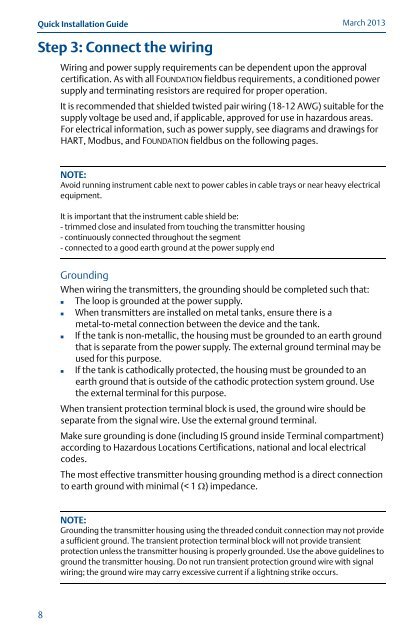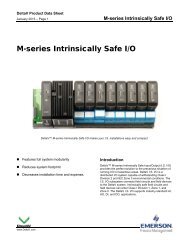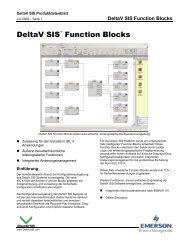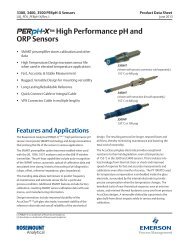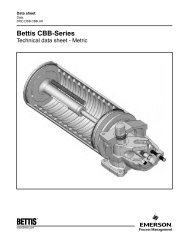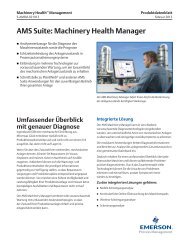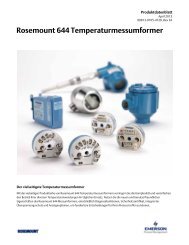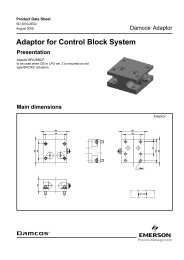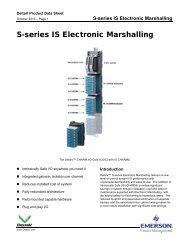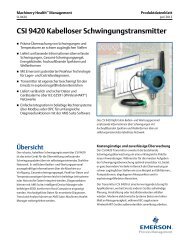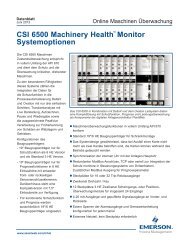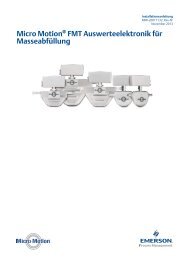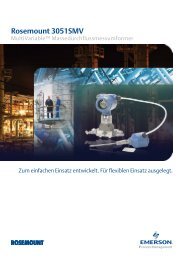Rosemount 5300 Series Superior Performance Guided Wave Radar ...
Rosemount 5300 Series Superior Performance Guided Wave Radar ...
Rosemount 5300 Series Superior Performance Guided Wave Radar ...
You also want an ePaper? Increase the reach of your titles
YUMPU automatically turns print PDFs into web optimized ePapers that Google loves.
Quick Installation Guide<br />
Step 3: Connect the wiring<br />
8<br />
March 2013<br />
Wiring and power supply requirements can be dependent upon the approval<br />
certification. As with all FOUNDATION fieldbus requirements, a conditioned power<br />
supply and terminating resistors are required for proper operation.<br />
It is recommended that shielded twisted pair wiring (18-12 AWG) suitable for the<br />
supply voltage be used and, if applicable, approved for use in hazardous areas.<br />
For electrical information, such as power supply, see diagrams and drawings for<br />
HART, Modbus, and FOUNDATION fieldbus on the following pages.<br />
NOTE:<br />
Avoid running instrument cable next to power cables in cable trays or near heavy electrical<br />
equipment.<br />
It is important that the instrument cable shield be:<br />
- trimmed close and insulated from touching the transmitter housing<br />
- continuously connected throughout the segment<br />
- connected to a good earth ground at the power supply end<br />
Grounding<br />
When wiring the transmitters, the grounding should be completed such that:<br />
The loop is grounded at the power supply.<br />
When transmitters are installed on metal tanks, ensure there is a<br />
metal-to-metal connection between the device and the tank.<br />
If the tank is non-metallic, the housing must be grounded to an earth ground<br />
that is separate from the power supply. The external ground terminal may be<br />
used for this purpose.<br />
If the tank is cathodically protected, the housing must be grounded to an<br />
earth ground that is outside of the cathodic protection system ground. Use<br />
the external terminal for this purpose.<br />
When transient protection terminal block is used, the ground wire should be<br />
separate from the signal wire. Use the external ground terminal.<br />
Make sure grounding is done (including IS ground inside Terminal compartment)<br />
according to Hazardous Locations Certifications, national and local electrical<br />
codes.<br />
The most effective transmitter housing grounding method is a direct connection<br />
to earth ground with minimal (< 1 ) impedance.<br />
NOTE:<br />
Grounding the transmitter housing using the threaded conduit connection may not provide<br />
a sufficient ground. The transient protection terminal block will not provide transient<br />
protection unless the transmitter housing is properly grounded. Use the above guidelines to<br />
ground the transmitter housing. Do not run transient protection ground wire with signal<br />
wiring; the ground wire may carry excessive current if a lightning strike occurs.


